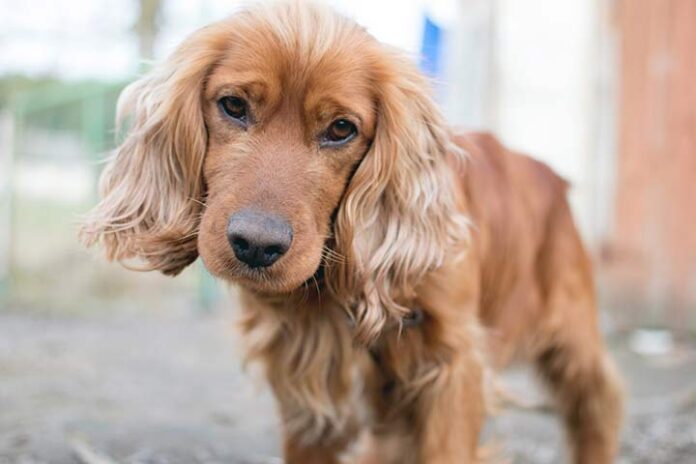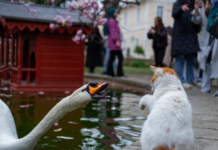Last Updated on August 19, 2023 by Fumipets
Discovering the Enchanting Cocker Spaniel
The article “Discovering the Enchanting Cocker Spaniel” is an informative guide to the beloved Cocker Spaniel breed. It explores the breed’s origin, characteristics, temperament, and care requirements.
From its history as a versatile hunting dog to its role as a cherished family companion, this article provides a comprehensive overview of the Cocker Spaniel’s appeal.
Cocker Spaniel
Cocker spaniels are wonderful family pets because they are devoted, laid-back, and affectionate. They are often intelligent and simple to train. They are also perfect for any size home, from an apartment to a single-family home, due to their comparatively tiny size—they grow to be approximately 14–15 inches tall and weigh little more than 30 pounds.
They are very obedient animals and will follow you around the house the whole day. Cockers also like taking quick strolls and seem to be having fun wherever they go. Although they were first developed as hunting dogs, they today make excellent companions for both young and senior pet owners.
Appearance
Cocker spaniels are gorgeous, medium-sized canines. Female dogs reach a height of 14 inches, while male puppies reach a height of 15 inches. They should not be heavier than 30 pounds, so please assist them avoid overeating.
Cocker spaniels have long, luscious ears that people can’t help but touch, and their thick, velvety, wavy coats come in a variety of colors and patterns, including black, light cream, red, white, and brown. The expression “sweet puppy dog eyes” was probably made popular by cocker spaniels, who have large, wistful, beseeching brown eyes. But they need continual care for their appearance, both at home and at the groomer.
The English cocker spaniel and the cocker spaniel, sometimes known as the American cocker spaniel, are two quite different breeds. The cocker spaniel is longer than she is tall, but an English cocker spaniel is taller than she is long, despite the fact that both breeds have the same ancestry. The cocker spaniel’s eyes are more almond-shaped, and her snout is shorter than those of her English counterparts.
Temperament
Cocker spaniels are a joyful breed. They are also intelligent and obedient to their masters. Despite having a natural propensity for hunting, they are most content when they are a companion at home.
They will do everything their owner asks them to since they like nothing more than making their human family happy. Would you want to curl up on the couch? The dog is a cocker spaniel. Would the kids want to play in the yard? They are also game for it. Additionally, despite their initial restraint, cocker spaniels quickly become friends with the majority of people.
They are loving and cuddly dogs with a gentle demeanor. Additionally, they get along well with other animals, even cats, given the right training. However, because of their natural hunting propensities, it is not usually possible to have a pet bird in the house.

Living Needs
“Cocker spaniels are a beautiful breed with a very nice size, big enough to be sturdy and able to play with kids, but small enough to be an apartment or condo dog,” claims Ryan Steen, DVM, medical director of Frey Pet Hospital in Cedar Rapids, Iowa. It’s a match made in heaven as long as your cocker spaniel is reared with youngsters who are polite and sensitive to animals.
Your cocker spaniel will desire to spend as much time with you as possible because of his people-oriented attitude. They really flourish when they can participate in all family activities and appreciate being a member of the family. They struggle when left alone and, when stressed, might exhibit unwanted behaviors like barking and wailing. They will dig or bark to pass the time if left outside.
Due to her hunting ancestry, your cocker spaniel will undoubtedly enjoy cuddling up on your lap, but you must make sure she gets enough exercise as well. Unlike adult cocker spaniels, who need 30 minutes of exercise twice day and extra free time to play—they particularly like a good game of fetch—cocker spaniel pups will tire out after a short stroll. Because cocker spaniels love snacks, exercise not only aids in weight management but also prevents your dog from becoming grumpy.
Care
Continual grooming will be required if you acquire a cocker spaniel, warns Steen. They maintain their finest appearance by getting regular haircuts that preserve their hair from matting.
Ask the groomer to give your cocker spaniel a “puppy cut,” or uniformly trimmed hair all over, for a low-maintenance look. No of the style, their distinctive floppy ears are typically preserved with longer hair and need to be checked for matting. Early grooming introduction may result in more successful groomer appointments with your cocker spaniel. Be prepared to schedule frequent grooming visits, which may be costly (often every six to eight weeks).
Plan to brush often in between haircuts. Invest in a metal dog comb with fine and medium tooth spacing that is of professional grade. While brushing, if you come across a tangle, carefully pick your way through it. Regular bathing with high-quality dog shampoo and thorough rinsing are also crucial. Regular nail trimming and weekly ear cleaning are both recommended to prevent infections.
Take precautions to prevent their ears from becoming wet each time they have a sip of water. Use deep, narrow bowls for food and water, or think about giving your cocker spaniel a snood to cover her ears while she eats.
Cocker spaniels are calm and kind, making them excellent therapy dogs. Because Cocker Spaniels are good at paying attention and obeying instructions, they are a versatile breed that may also be taught for agility courses.
Patience and repetition are necessary throughout training. Make sure to deal with barking right away. Cocker spaniels are known for marking their territory inside when aroused or scared, so toilet training will take a while. It will work if you provide a lot of positive reinforcement over time. Being kind and compassionate will bring out the best in a cocker’s nature since they are sensitive and don’t react well to harsh treatment.
Make sure to give your cocker spaniel regular grooming if you decide to get one. They look their best when they have regular haircuts, which also maintain their hair from matting.
Health
Despite being a generally healthy breed with an average lifespan of 12 to 15 years, owners of cocker spaniels should be aware of a few prevalent ailments.
One of the most typical conditions I find in cocker spaniels is allergies, and recurrent ear infections are another, according to Steen. Due to prevalent sensitivities to beef, poultry, maize, wheat, soy, milk, and eggs, their diet may be to blame. For advice on dietary adjustments for your pet, see your veterinarian.
Also, watch out for overfeeding your dog. When feeding time comes around, they will overeat and try to persuade you they need a second helping with their huge, brown eyes. However, an obese cocker is a sick cocker.
Cocker spaniels are susceptible to cancer as they age, as well as heart, liver, or renal failure. Epilepsy, progressive retinal atrophy, which results in blindness, and cataracts, which need pricey surgical treatment, are other conditions that might sometimes afflict cocker spaniels.

History
It has been shown that the cocker spaniel originated in Spain as early as the 14th century. They were split into two categories by the 1800s: toys (used for companionship) and hunting dogs. They were given their name for their skill in woodcock field hunting, and in 1892, England recognized them as a distinct breed. It is believed that the pilgrims introduced cocker spaniels to North America. In actuality, the American Spaniel Club, which was founded in 1881, is the country’s first breed organization.
Cocker spaniels swiftly gained popularity among breeders and pet owners, and they excelled in the show ring. The Westminster Kennel Club’s Best in Show award was originally won by a cocker spaniel in 1921. The American Kennel Club recognized the English and American cocker spaniels as separate breeds in 1946.
Questions & Answers:
What is the origin of the Cocker Spaniel breed?
The Cocker Spaniel originated in the United Kingdom and was bred for hunting small game, particularly woodcock. Over time, it evolved into distinct American and English varieties, each with its own traits and characteristics.
What are the key characteristics of Cocker Spaniels?
Cocker Spaniels are medium-sized dogs known for their attractive coats, expressive eyes, and long ears. They come in a variety of coat colors and patterns, and their tails are typically docked. Their friendly demeanor and intelligent expression are among their most notable features.
What is the temperament of Cocker Spaniels?
Cocker Spaniels are known for their affectionate and gentle nature. They are often eager to please, making them great companions for families and individuals alike. They are also intelligent and trainable, though early socialization and training are important to ensure a well-rounded adult dog.
What care requirements do Cocker Spaniels have?
Cocker Spaniels require regular grooming due to their lush coat, which can be prone to matting and tangling. Routine brushing, ear cleaning, and nail trimming are essential. Regular exercise is also important to keep them physically and mentally stimulated, as they are an energetic breed.
Are there any health considerations for Cocker Spaniels?
Cocker Spaniels can be prone to certain health issues, including ear infections due to their pendulous ears, as well as eye conditions. Responsible breeding practices and regular veterinary check-ups can help mitigate these concerns and ensure a healthy and happy Cocker Spaniel.
“Discovering the Enchanting Cocker Spaniel” offers valuable insights into the breed’s history, traits, care, and health considerations, making it a must-read for anyone considering bringing a Cocker Spaniel into their home.


















